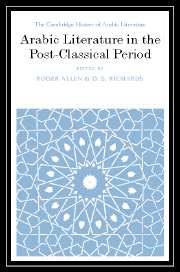10 - Popular poetry in the post-classical period, 1150–1850
from Part III - Popular poetry
Published online by Cambridge University Press: 28 March 2008
Summary
If it is the post-classical period of Arabic literature that has received the least scholarly attention of all eras of Arabic literature, it is undoubtedly the sub-field of‘popular literature’ that has suffered the most neglect. While some of the gaps in our knowledge of popular literature in the modern period have, in recent years, been filled in, the earlier periods remain largely understudied. In this chapter we will briefly shift the focus to one segment of this most understudied area of Arabic literature, namely popular poetry of the post-classical period. From the outset the term ‘popular poetry’ requires some discussion and qualification. In the next few pages, while attempting to sort out some of the apparent problems with the use of this term, we will roughly delimit the area of poetic production that we are concerned with and defend the use of this term as the best of an inexact lot for what is in fact a very diverse area of Arabic poetic production.
Most of what we know as Arabic poetry’ is, of course, poetry produced in fushā or classical Arabic by court poets or the poets of the rich and famous, in other words, the creative currency of a privileged sliver of society. Those who possessed sufficient power and wealth engaged the services of poets whose main activity was the creation of panegyrics in their honour intended to enhance their benefactors’ prestige. The classical qasīda, or ode, with its mostly predictable roster of motifs, was the conventional form that such tributes took.
- Type
- Chapter
- Information
- Arabic Literature in the Post-Classical Period , pp. 189 - 242Publisher: Cambridge University PressPrint publication year: 2006
References
- 1
- Cited by



